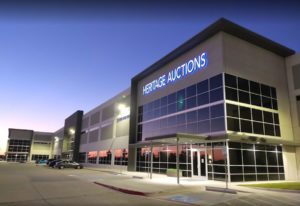Dale Chihuly is one of the best-known Studio Glass artists. If you do not know his name, you have surely seen one of his bright, eccentric glass creations. They come in all forms – elaborate chandeliers, hanging sculptures, fantastical vases – all looking as if they belong in the future or on some beautiful, alien planet. Chihuly was also one of the pioneers of the Studio Glass movement and was trained by the man who began it all: Harvey Littleton.
Littleton was a respected pottery instructor at the University of Wisconsin-Madison (UW). After returning from a visit to Europe, where he spent significant time in the art glass capital of Murano, Italy, Littleton felt inspired to experiment with glass and its properties. Littleton’s father was the head of research at Corning Glass Works, so he had a good handle on how to work glass but the art of making glass was considered something that had to be done in a large factory with a glass oven. In 1962, the Toledo Museum of Art took notice of his experiments with glass and suggested that he present a glassblowing seminar at the museum. Two seminars were held in a shed at the museum in 1962, and one of the eight attendees was glass research scientist Dominick Labino. Littleton joined forces with Labino, who lent financial aid through Johns Manville Fiber Glass where he was head of research, as well as his expertise. Through his research, Labino built the first small, portable furnace to melt glass, and the pair created a formula with which glass could be melted at a low temperature, and then hold a consistency suitable for blowing glass. Assorted ways of working with glass were developed by artists like Edris Eckhardt with her personal glass formulas and pottery kiln as well as the glass blowers in Milano, but Littleton and Labino helped to make these methods available to the everyday artist and made Studio Glass products available to the public.
With the new accessibility to creating quality glass art, the Studio Glass Movement took off. Littleton began his own glass department at UW and taught artists – including Dale Chihuly, Fritz Dreisbach, Marvin Lipofsky and many others – who would become household names to collectors of Studio Glass. The Studio Glass Movement was born and is characterized by artists’ use of glass as a medium to produce artworks. Studio Glass normally is not functional but can produce one-of-a-kind pieces made in a studio setting. They are usually unique pieces, with ribbons of color or different types of materials running through them. Littleton often utilized streaks of layered colors in elegant shapes in his art works. Chihuly uses a huge variety of colors and color blending techniques, but all of his pieces are in grandiose and vivid shapes and twisted sculptural forms with wispy curly cues. Dreisbach preferred small threads of color running through an otherwise monotone piece, thicker ribbing and more solid shapes.
During this era, Studio Glass was thought to be somewhat synonymous with glassblowing, but Bullseye Glass Company made a distinct differentiation in the 1980s with new techniques for kiln-forming glass. Bullseye Glass Co. made a concerted marketing effort to establish Studio Glass as an official movement and sponsored Studio Glass departments in universities around the world. The Studio Glass Movement reach its critical mass in popularity and production in the 1990s. After the turn of the century, Studio Glass continues to carry a strong market and continues to evolve and grow to meet new demands and new techniques. Littleton succeeded in turning an industrial material into a widely received artistic medium.
Art Glass vs. Studio Glass
Art Glass and Studio Glass are often confused. While a serious collector of either movement can instantly tell if a piece is Studio Glass or Art Glass, the line is a little more vague for the general observer. Art Glass was mostly made in the early 20th century and much of it is Art Deco or Art Nouveau style. During the Art Glass era, glass was perceived largely as a medium that only could be worked in large factories built for melting glass at high temperatures and poured into molds. Thus Art Glass pieces sometimes are artistic pieces but are not always unique.
“The Western Art Glass movement really begins in Stourbridge, England at the firms of Thomas Webb and Stevens & Williams, and involves Victorian efforts to recreate ancient glassmaking techniques used up to the late Roman Empire and generally lost through the European Dark Ages,” said Nick Dawes, VP of Special Collections and Art Glass Specialist. “This was mainly ‘cameo’ (Roman) glass, first recreated in England, then ‘pate-de-verre’ (earlier, Egyptian), revived in France. Most other ancient techniques, including internal decoration, remained known and were practiced in Venice and elsewhere.”
Art Glass often is used as a generic term that envelopes glass made between 1875 and 1945, and therefore can include Studio Glass, although most collectors differentiate it by the style in which it was made. Though both terms suggest artisanal work with glass, the Art Glass Movement refers more to factory production, while Studio Glass movement refers more to hand-made pieces. The great artisans of Art Glass would include names with which many are extremely familiar, including Steuben, Tiffany, Daum, Galle and Lalique. Each of these companies began with an artist – Steuben with Frederick Carder, Tiffany with Charles Lewis Tiffany, Daum by Jean Daum, etc. – and created an original, marketable style of glass designer pieces to produce in its respective factory and then release to the public. They tend to be more functional than Studio Glass as well.
There is some discussion about whether factory-made glass like this can be called Art Glass. Some collectors prefer that it not be included under the term Art Glass, but there is no denying the artistry in some of these pieces of factory-made glass. For instance, Frederick Carder began working with glass at Stevens & Williams in 1881. There, he re-introduced the idea of colored glass, worked with Peter Faberge and compiled the experience of glassmakers from all over the world, ultimately creating a name for himself at Steuben Glass Works with Thomas J. Hawkes. He oversaw projects like the creation (in collaboration of Lee Lawrie and Attilio Piccirilli) of the cast panels for Rockefeller Center in New York City. He also created smaller one-of-a-kind pieces, including all of the techniques he had learned from his travels. Carder made his mark on the glassmaking world and was shown in 1939 at The World of Tomorrow exhibition at New York World’s fair. There is no denying the artistry that Carder utilized to create glass in his factory or the scientific advancements he made in his field. Carder developed unique formulas for glass and crystal that exceeded all that was known about the medium.
Art Glass and Studio Glass share very similar space in history in some respects. Both are reflections of the artists and their creativity within a seemingly limited medium, and both use color and shape to reflect the ideals of the era and of the artists. But ultimately, Studio Glass is glass art made by an artist in a small studio, by using materials accessible to the everyday artist. The Art Glass Movement in its strictest form is glass designed by an artist and created in a factory with a mold. To see various forms of Studio Glass and Art Glass, check out our upcoming Design and Pre-War Design Including Art Glass auctions. Can you see the difference?


Leave a Comment